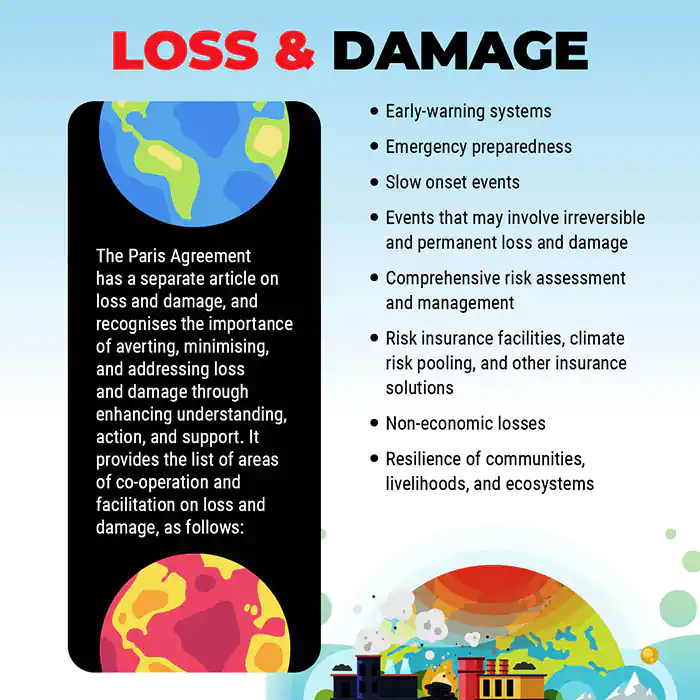Ahmedabad
(Head Office)Address : 506, 3rd EYE THREE (III), Opp. Induben Khakhrawala, Girish Cold Drink Cross Road, CG Road, Navrangpura, Ahmedabad, 380009.
Mobile : 8469231587 / 9586028957
Telephone : 079-40098991
E-mail: dics.upsc@gmail.com

Loss and Damage Fund
News: Loss and Damage Fund is in sharp focus due to the upcoming UNFCCC Conference of Parties (COP 28) to be held in the UAE.
What is Loss and Damage Fund?
• The Loss and Damage Fund is a significant outcome of the United Nations Climate Conference (COP 27). It was established in response to decades of pressure from climate-vulnerable developing countries.
• The fund’s primary goal is to provide financial assistance to nations that are most vulnerable and impacted by the effects of climate change.
• “Loss and Damage” refers to the negative consequences that arise from the unavoidable risks of climate change, like rising sea levels, prolonged heatwaves, desertification, the acidification of the sea, and extreme events, such as bushfires, species extinction, and crop failures.
Genesis and Evolution of LDF
| Historic Pollution Accountability | For over 30 years, there has been a call for affluent nations to acknowledge their historical pollution accountability |
| COP19 Agreement (2013) | At COP 19 in Warsaw, Poland, in 2013, member countries formalized the creation of the Loss and Damage fund. |
| Subsequent Developments | COP 25 introduced the Santiago Network for Loss and Damage, and COP 26 established the Glasgow Dialogue on finance for Loss and Damage |
| COP27 (November 2022) | COP 27 saw the creation of the Loss and Damage fund and a Transitional Committee (TC) tasked with operationalizing the fund |
Need and Basis of LDF:
• Historically, G20 countries have emitted the majority of the greenhouse gases driving the climate crisis. For instance, the African continent contributes the least to climate change yet is the most vulnerable to its impacts. G20 countries, meanwhile, represent around 75% of global greenhouse emissions.
• The fund aims to compensate for these “loss and damage” impacts that cannot be avoided either by mitigation (cutting greenhouse gas emissions) or adaptation (modifying practices to buffer against climate change impacts).
• The fund is based on the “polluters pay principle “. It makes the polluter liable for paying the cost of remedial action and compensation for the victims of environmental damage caused by their actions. Thus, the rich and developed nations, which are majorly responsible for industrial emissions, must pay the poorer nations that have made negligible contribution to global warming.
Challenges associated with operationalizing LDF:
• Reluctance of Developed Nations: There is a reluctance among developed nations to accommodate a new fund. There is also political unwillingness to commit to higher, additional non-debt finance to official development assistance (ODA) as well as to deliver on previous commitments. For example, USA hasn’t committed on the fund.
• Definition of Loss and Damage: There is an absence of a mutually agreed upon definition to categorise Loss and Damage activities that overlap with humanitarian support.
• Rejection of Common But Differentiated Responsibilities (CBDR) principle- The developed countries have rejected references to the CBDR, equity, and liability in the fund’s draft. This has watered down the spirit and intent of the L&D fund.
• Technical Capacity: Especially in developing countries, there is a low technical capacity to scientifically model Loss and Damage, which makes it difficult to make robust estimates.
• Immediate Accessibility to Funds: Immediate accessibility to funds has remained elusive in the domain of climate finance.
Consequences of Inaction over LDF
• It threatens Climate Justice. Vulnerable nations and people will continue to suffer
• Without LDF, there will be limited capacity to address serious environmental issues such as environmental degradation, loss of ecosystems.
• Increased incidence of Food shortages, human displacement.
• Widen the gap between developed and developing countries.
Way Forward
• Encourage developed nations to actively contribute as primary donors to the LDF.
• The windfall tax on oil and gas company’s profits can be used to fund the Loss and Damage Fund.
• Implementation of the German backed “Global Shield Scheme against climate risks”

Address : 506, 3rd EYE THREE (III), Opp. Induben Khakhrawala, Girish Cold Drink Cross Road, CG Road, Navrangpura, Ahmedabad, 380009.
Mobile : 8469231587 / 9586028957
Telephone : 079-40098991
E-mail: dics.upsc@gmail.com
Address: A-306, The Landmark, Urjanagar-1, Opp. Spicy Street, Kudasan – Por Road, Kudasan, Gandhinagar – 382421
Mobile : 9723832444 / 9723932444
E-mail: dics.gnagar@gmail.com
Address: 2nd Floor, 9 Shivali Society, L&T Circle, opp. Ratri Bazar, Karelibaugh, Vadodara, 390018
Mobile : 9725692037 / 9725692054
E-mail: dics.vadodara@gmail.com
Address: 403, Raj Victoria, Opp. Pal Walkway, Near Galaxy Circle, Pal, Surat-394510
Mobile : 8401031583 / 8401031587
E-mail: dics.surat@gmail.com
Address: 303,305 K 158 Complex Above Magson, Sindhubhavan Road Ahmedabad-380059
Mobile : 9974751177 / 8469231587
E-mail: dicssbr@gmail.com
Address: 57/17, 2nd Floor, Old Rajinder Nagar Market, Bada Bazaar Marg, Delhi-60
Mobile : 9104830862 / 9104830865
E-mail: dics.newdelhi@gmail.com